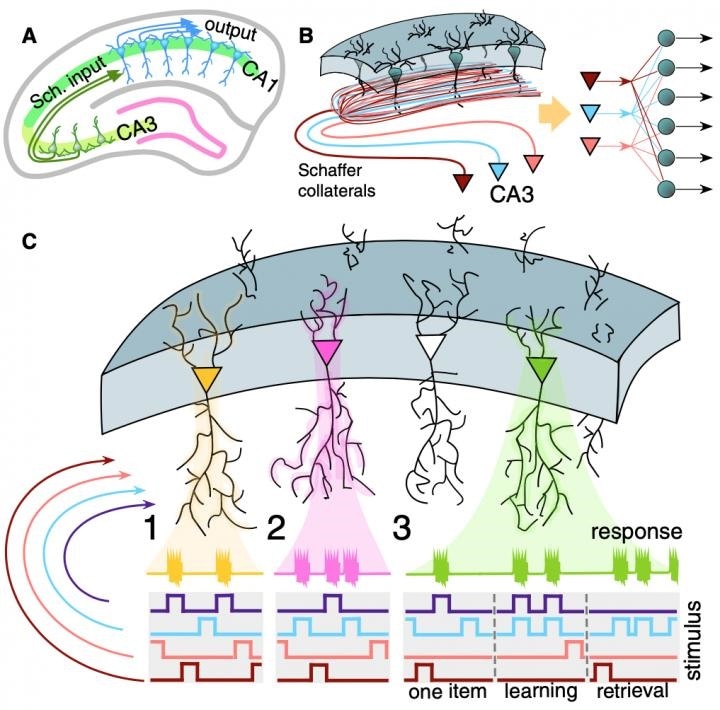For the first time, a team of researchers from Lobachevsky University with collaborators has theoretically validated the existence of concept cells.

The scheme of the neural network. Image Credit: Valery Makarov.
Individual neurons are known to exist, and each of these neurons is in charge of its own abstract concept, like the musical note “A.” By using the case of Beethoven’s Ninth Symphony, scientists have demonstrated the functions of these cells.
However, the evidence of the presence of such cells refutes the general consensus that the development of abstract concepts in the human brain takes place only through the stimulation of large neuronal complexes. This latest discovery can also play a highly significant role in the emergence of artificial neural networks.
Valery Makarov, Senior Researcher of the Fundamental and Applied Research Department at the Centre for Translational Technologies and Head of the RSF grant project, described that the brain of all living beings is highly complex.
A key role in the brain is played by neurons, the nervous system cells that are responsible for receiving, processing, storing and transmitting signals. Currently, a common opinion prevails in science that the emergence of abstract concepts in the human brain requires complex, perfectly orchestrated interaction of myriads of neurons.”
Valery Makarov, Senior Researcher, Fundamental and Applied Research Department, Centre for Translational Technologies, Lobachevsky University
Makarov continued, “However, there is a hypothesis that suggests that single neurons, the so-called concept cells, may be responsible for complex tasks performed by humans. These are individual neurons that form abstract concepts based on specific stimuli to which they respond, for example, the name of a human being. Thus, earlier the ‘Jennifer Aniston neuron’ was discovered, which fired whenever the portrait of the actress appeared on the screen. Such neurons that respond to the presentation of some image are called ‘grandmother cells’.”
Scientists had proposed that concept cells can also play a major role in episodic memory. The existence of these cells questions the usual hypothesis that complex cognitive processes need flawlessly arranged interaction of multiple neurons.
For the first time, Lobachevsky University scientists along with their foreign collaborators have developed a novel model that mimics the work of neurons in the hippocampus. Hippocampus is part of the brain that is specifically responsible for memory as well as orientation in space.
Using mathematical calculations, we have identified three fundamental principles that provide high cognitive abilities of individual cells. First, it is a strict hierarchy of neural layers. We investigated the links between the selective and concept layers of neurons. The first one isolates signals, while the second one processes them and links them with abstract concepts. Secondly, we have paid attention to the links of one neuron at the concept level with many receiving neurons.”
Valery Makarov, Senior Researcher, Fundamental and Applied Research Department, Centre for Translational Technologies, Lobachevsky University
Makarov continued, “Thirdly, we have found that synaptic plasticity, i.e. change of information transfer force between neurons, plays an important role. These theoretical principles allow the cells of the concept layer to learn and significantly increase their cognitive abilities, as a result of which they become concept cells.”
The study’s authors used musical notes to demonstrate the possibility of such a type of learning. They created a neural network containing 1600 cells at the concept level and 3200 cells at the selective level. The cells were subjected to eight different sound waves, each having eight stage shifts, that is, oscillations.
Neurons detected these oscillations as individual signals, so there were around 50 receiving level neurons for each signal. At first, the researchers could detect a broad range of haphazard signals, but after training, their area of action turned out to be more specialized and narrow.
An experiment performed with Beethoven’s Ninth Symphony has shown that individual sound waves were captured by receiving neurons, and at the concept level, the cells processed the received data and established which note was played, serving as concept cells.
Modern artificial neural networks mimic the structure of biological systems. As a result, they are already superior to humans in pattern recognition, but still lag behind in cognitive abilities. Therefore, to make new steps in this field, we need novel biophysical insights on how the brain understands information. The discovery of concept cells, whose existence can now be justified by three fundamental principles, is of great importance for neurobiology and neural network theory.”
Valery Makarov, Senior Researcher, Fundamental and Applied Research Department, Centre for Translational Technologies, Lobachevsky University
Source:
Journal reference:
Tapia, C. C., et al. (2020) Universal principles justify the existence of concept cells. Scientific Reports. doi.org/10.1038/s41598-020-64466-7.